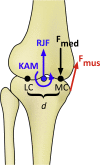Medial knee joint contact force in the intact limb during walking in recently ambulatory service members with unilateral limb loss: a cross-sectional study
- PMID: 28168120
- PMCID: PMC5292027
- DOI: 10.7717/peerj.2960
Medial knee joint contact force in the intact limb during walking in recently ambulatory service members with unilateral limb loss: a cross-sectional study
Abstract
Background: Individuals with unilateral lower limb amputation have a high risk of developing knee osteoarthritis (OA) in their intact limb as they age. This risk may be related to joint loading experienced earlier in life. We hypothesized that loading during walking would be greater in the intact limb of young US military service members with limb loss than in controls with no limb loss.
Methods: Cross-sectional instrumented gait analysis at self-selected walking speeds with a limb loss group (N = 10, age 27 ± 5 years, 170 ± 36 days since last surgery) including five service members with transtibial limb loss and five with transfemoral limb loss, all walking independently with their first prosthesis for approximately two months. Controls (N = 10, age 30 ± 4 years) were service members with no overt demographical risk factors for knee OA. 3D inverse dynamics modeling was performed to calculate joint moments and medial knee joint contact forces (JCF) were calculated using a reduction-based musculoskeletal modeling method and expressed relative to body weight (BW).
Results: Peak JCF and maximum JCF loading rate were significantly greater in limb loss (184% BW, 2,469% BW/s) vs. controls (157% BW, 1,985% BW/s), with large effect sizes. Results were robust to probabilistic perturbations to the knee model parameters.
Discussion: Assuming these data are reflective of joint loading experienced in daily life, they support a "mechanical overloading" hypothesis for the risk of developing knee OA in the intact limb of limb loss subjects. Examination of the evolution of gait mechanics, joint loading, and joint health over time, as well as interventions to reduce load or strengthen the ability of the joint to withstand loads, is warranted.
Keywords: Gait; Load; Military; Osteoarthritis; Prosthesis; Transfemoral; Transtibial.
Conflict of interest statement
The authors declare there are no competing interests.
Figures






References
-
- Bell AL, Brand RA, Peterson DR. Prediction of hip joint centre location from external landmarks. Human Movement Science. 1989;8(1):3–16. doi: 10.1016/0167-9457(89)90020-1. - DOI
LinkOut - more resources
Full Text Sources
Other Literature Sources

